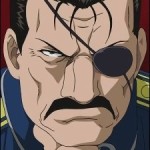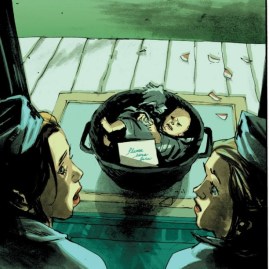Tagged: David McCain, Huck, Image Comics, Mark Millar, Nate Piekos, Rafael Albuquerque
- This topic has 1 reply, 2 voices, and was last updated 8 years, 2 months ago by
 Jacob Kellogg.
Jacob Kellogg.
-
AuthorPosts
-
-
February 4, 2016 at 11:54 PM #2031
 Leon EvelakeModerator
Leon EvelakeModerator
Huck Issue #1 Review

Huck
Published by: Image Comics
Writer: Mark Millar
Artist Rafael Albuquerque (pencils and inks)
Colorist: David McCain
Letterer: Nate Piekos
Since the early 2000s comic writer Mark Millar has become one of industry’s most prolific and effective writers. His works with Marvel have met with considerable critical and financial success. Starting with Ultimate X Men and through other works such as the insanely well received Ultimates, Civil War (the conceptual basis for the 2016 movie) and Incredibly good and rightfully beloved Old Man Logan Millar moved himself into a place of prominence in the industry.
 Capitalizing on his success at Marvel Millar began to produce creator owned works many under his own Millerworld imprint. Many of his works have been made into feature films (some having the right sold before the first issue even his comic stores, including Huck). In fact it may be true that only Stan Lee and Kazuo Koike have had more live action works based on their comics.
Capitalizing on his success at Marvel Millar began to produce creator owned works many under his own Millerworld imprint. Many of his works have been made into feature films (some having the right sold before the first issue even his comic stores, including Huck). In fact it may be true that only Stan Lee and Kazuo Koike have had more live action works based on their comics. A almost trademark of these works is their mostly stand alone almost movie like story structure (in fact a common claim is that they are thinly veiled movie proposals) and cynical and considerably dark tone often punctuated with a more harsh realistic approach to the consequences of violence; Wanted, Kick Ass, Nemesis, Secret Service (later dubbed Kingsmen Secret service) and to a degree Supercrooks being good examples of this.
 But while his works have been notably adult, grim,violent (to the point of being often accused of relying on shock value) and in Wanted’s case unpleasant and borderline nihilistic, Millar has shown a remarkable ability to write hopeful, inspiring superhero tales (particularly in the Superman mold). Superior is quite possible one of the best superhero comics of the last decade. And while Jupiter’s Legacy certainly has the much of hallmarks of Millar’s darker works it manages a unique and rather effective balance.
But while his works have been notably adult, grim,violent (to the point of being often accused of relying on shock value) and in Wanted’s case unpleasant and borderline nihilistic, Millar has shown a remarkable ability to write hopeful, inspiring superhero tales (particularly in the Superman mold). Superior is quite possible one of the best superhero comics of the last decade. And while Jupiter’s Legacy certainly has the much of hallmarks of Millar’s darker works it manages a unique and rather effective balance.
Millar’s latest work Huck seems to be his ultimate reversal on the trend of dark and gritty superheroes that he helped codify for the modern era. A trend that he much like Alan Moore (who helped birth it) seems to think it has gotten out of hand and been applied to character it should not be. In particular Millar said he at least in part made the series in response to the 2013 Superman Movie Man of Steel.As he wrote in How Man Of Steel Traumatized Me So Much I Created Huck
” I sat there on Father’s Day and saw Superman beating the bad guy by twisting his neck so hard he broke it and murdered him I really wondered if we’d come to the end of that particular road.
Now I got the logic of that scene and it absolutely made sense within the context of the movie as the villain had taken down half of Metropolis and killed hundreds of thousands of people. But even so. This was Superman. This was like seeing Sylvester the Cat finally getting his hands on Speedy Gonzales. Elmer Fudd blowing away Bugs Bunny. I loved Superman as a kid not because of his edginess or his potential for a fatal solution, but because he could do anything he wanted and still chose to be nice. This was always the moral of a superhero comic to me. “

Issue One of Huck primarily takes place in a small Midwestern town that is evocative of the 1940s or 50s taking the best elements of small town America. Its Bedford Falls without Mr Potter, it Smallville it’s the type of town where kind people live out relatively simple lives and know their neighbors secluded from the larger part of the modern society. It’s a little piece of a past that never really existed as much as we wanted it to.
Growing up in this idyllic town is Huck a young man who was abandoned outside an orphanage wrapped in a basket with a note reading simply “Please love him”. To outsiders Huck seems a tad simple or slow whilst one ms Taylor insists he just wise and quiet. Huck was raised to do a good deed every day. And has taken that to heart. Each day he sets out to help the people of his town in various ways. Finding lost items, running Christmas cards across the country (without tiring), taking out the entire town’s garbage on garbage day, or single-handedly pulling cars from ditches. All he asks is that the people he helps tell no one. Clearly he is special and has abilities beyond normal but the people of his home town are content to not question it.

One Day while planning potential good deeds for the next day Huck sees the news covering the kidnapping of two hundred girls by Boko Haram. So he sets upon rescuing them. But taking such a high-profile action is not easily kept quiet and his peace and seclusion may be at an end.
Issue one is a fast and pleasant read, Millar’s goal of crafting a hero reminiscent of Jimmy Stewart and Tom Hanks is well executed and intriguing even if the book has yet to show much of his personality outside the actions he takes for his town. Rafael Albuquerque’s art is vivid and captures the hopeful innocence of the title character as well as the simple beauty of his home town. Millar said he wanted to tell an uplifting feel good superhero story that reminded us that we didn’t love these characters as children because they were badasses and brutal but because they were something to aspire to. Millar says “Huck is the antidote to the antihero”. And I kind of hope he is right.

[See the full post at: Huck Issue #1 Review] -
February 5, 2016 at 12:59 AM #2040
 Jacob KelloggKeymaster
Jacob KelloggKeymaster““Huck is the antidote to the antihero”. And I kind of hope he is right”-Sold.
-
-
AuthorPosts
- You must be logged in to reply to this topic.





